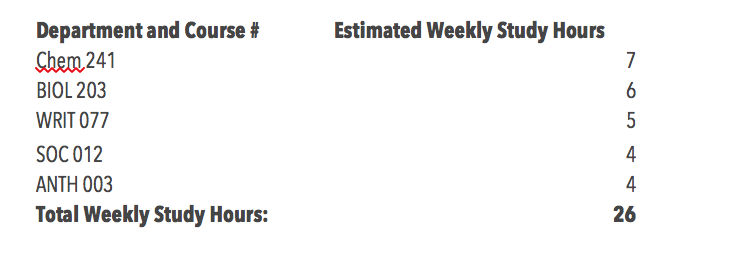Many of the students I see in the Weingarten Center come in because they feel like they are not using their time efficiently or are studying all the time. When I ask them how they schedule their day and manage their workflow, many students pause then explain that they keep their schedules, deadlines, and assignments in their head, referring to planners or schedules as too rigid. There are many stated reasons that students dislike the rigidity of keeping a planner or calendar, but the most common objection is that the perceived rigidity stresses them out, or they feel they don’t have enough time in their day as it is, so planning daily would be another burden added on to an already stacked plate. The reality is that it takes time to develop new habits and planning sufficiently should reduce feelings of stress over time. There are a variety of resources students can use to fit all working styles such as Google Calendar, Apple iCal, a traditional paper planner and methods of planning referred to as “unscheduling.” This last one tends to resonate with students most hesitant about traditional planning methods. This blog post is the first in a series that will cover each one of these methods in detail. This first post will focus on traditional paper planning with electronic planning (via Google Calendar and iCal) and unscheduling to follow in subsequent posts.
For most students, my preferred approach to planning includes a combination of setting a regular but flexible weekly schedule, combined with making a daily task list. The first step I suggest to students is to make a list of all of their classes and then estimate a total number of hours of study time necessary to maintain academic success in each class. A typical schedule for a Penn student might look like this:

The next step in the process is to map a typical week on an hour by hour basis including class schedule, meals, work study, athletic requirements, sleep, and any other regular weekly meetings other commitments you might have and then fit in study time and self-care/free time in the remaining space. A typical student schedule may look like this:
Sample Schedule

This approach is also helpful when registering for classes. It is important to consider the demands of each class and how demanding they are of your time. There is only so much time in a day and making time for things such as self-care, exercise, sleep and free time is essential to prevent burnout and promote academic success. You may have noticed that I scheduled in general study time instead of assigning work for specific classes in each of those spaces. This is to allow for the flexibility that is necessary for the changing workloads typical in classes throughout the semester. A heavy week in one class may be paired with a light week in another class. I suggest students spend the first 15 minutes of their study time each day making a task list of work for the day. Make sure to break up assignments into smaller tasks of approximately 45 minutes for each task. This is referred to at Weingarten as “chunking your work” and should help to mitigate the desire to procrastinate. You should also take frequent study breaks of about 5-10 minutes after every 45-60 minute work session. This will help maximize productivity and increase knowledge retention.
Staff Writer: Randall Perez

